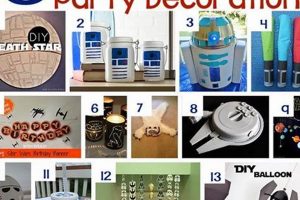The creation of festive ornaments and embellishments for the holiday season, utilizing confections as a primary material, represents a popular approach to seasonal crafting. Examples include gingerbread house adornments, candy cane wreaths, and ornaments crafted from hard candies. These projects often involve readily available materials and techniques adaptable to various skill levels.
Engaging in the creation of these festive items offers several benefits. It provides an opportunity for creative expression, can be a family-centered activity promoting bonding, and often presents a more cost-effective alternative to purchasing commercially produced decorations. Historically, the incorporation of edible elements into holiday decor reflects a tradition of abundance and celebration during the Christmas season.
The following sections will explore specific project ideas, material selection considerations, and techniques for ensuring the longevity and visual appeal of confectionery-based holiday embellishments. Safety guidelines for handling edible materials in crafting will also be addressed.
Tips for Creating Confectionery-Based Holiday Ornaments
Constructing decorations utilizing sweets necessitates careful planning and execution to ensure both visual appeal and structural integrity. The following tips provide guidance for successful project completion.
Tip 1: Material Selection is Crucial: Opt for candies with low moisture content to minimize the risk of deformation or stickiness. Hard candies, gumdrops, and certain types of molded chocolates are generally suitable choices.
Tip 2: Adhesive Considerations: Utilize food-safe adhesives, such as royal icing or melted sugar, for bonding confectionery components. Ensure the adhesive is appropriately viscous to provide adequate support without being excessively messy.
Tip 3: Structural Support is Essential: For larger projects, consider incorporating internal supports made of cardboard, wood skewers, or wire. These supports will prevent collapse and maintain the overall shape of the decoration.
Tip 4: Temperature and Humidity Control: Excessive heat or humidity can compromise the integrity of edible decorations. Store finished pieces in a cool, dry environment away from direct sunlight.
Tip 5: Protective Coatings: Applying a thin layer of edible glaze or sealant can help protect decorations from moisture and dust, extending their lifespan and preserving their visual appeal.
Tip 6: Food Safety Practices: Maintain stringent hygiene standards when handling edible materials. Wash hands thoroughly and utilize clean work surfaces and utensils to prevent contamination.
Tip 7: Careful Planning and Design: Before commencing construction, create a detailed plan or sketch of the desired ornament. This will facilitate the selection of appropriate materials and techniques, minimizing errors and waste.
Adhering to these guidelines will contribute significantly to the creation of durable and visually appealing confectionery-based holiday ornaments. The resulting decorations can enhance festive displays and provide lasting enjoyment.
The subsequent section will address common challenges encountered during the creation process and offer solutions for overcoming these obstacles.
1. Edible Material Selection
The selection of edible materials is a foundational element in the successful creation of confectionery-based holiday decorations. The characteristics of the chosen candies directly influence the structural integrity, aesthetic appeal, and longevity of the finished product.
- Moisture Content and Stability
Candies with high moisture content, such as marshmallows or soft caramels, are prone to deformation and stickiness under varying environmental conditions. Conversely, hard candies and molded chocolates with low moisture content maintain their shape and structural integrity for extended periods, making them more suitable for crafting decorations.
- Color and Aesthetic Harmony
The color palette and visual characteristics of the selected candies contribute significantly to the overall aesthetic of the decoration. The strategic combination of candies with complementary colors and textures can enhance the visual appeal of the finished product, creating a cohesive and visually stimulating design. For instance, pairing vibrant hard candies with the muted tones of gingerbread provides a balanced contrast.
- Structural Properties and Adhesion
The structural properties of the chosen candies influence their ability to adhere to each other and to supporting structures. Candies with smooth surfaces may require specialized adhesives or surface preparation to ensure adequate bonding. Alternatively, candies with irregular shapes or textured surfaces may offer better adhesion but present challenges in achieving a uniform appearance.
- Food Safety and Shelf Life
Considerations pertaining to food safety are paramount. Selecting candies with a long shelf life ensures that the finished decoration remains visually appealing and safe for display over an extended period. It is also essential to avoid candies that are known to attract pests or decompose rapidly, potentially compromising the hygiene and longevity of the decoration.
The deliberate and informed selection of edible materials, considering factors such as moisture content, color harmony, structural properties, and food safety, is essential for creating durable and visually appealing confectionery decorations. A thorough understanding of these properties allows crafters to optimize the design and construction process, ensuring that the finished product embodies both artistic expression and structural integrity.
2. Structural Integrity
Structural integrity is a critical factor determining the success and longevity of confectionery-based holiday decorations. The inherent properties of candies, often being fragile and susceptible to environmental conditions, necessitate careful consideration of structural principles during construction. The absence of sound structural design results in decorations prone to collapse, deformation, or detachment of components, ultimately diminishing their aesthetic value and lifespan. For example, a gingerbread house constructed without adequate reinforcement may buckle under its own weight, while ornaments made with improperly adhered candies may disintegrate due to gravity or temperature fluctuations.
Several strategies mitigate structural weaknesses. Internal supports, crafted from materials such as cardboard, wood skewers, or wire, provide a skeletal framework for larger decorations, distributing weight and preventing collapse. Food-safe adhesives, including royal icing or melted sugar, are crucial for bonding confectionery components securely. The selection of candies with inherent structural stability, such as hard candies or molded chocolates, minimizes the risk of deformation. Furthermore, the application of protective coatings, such as edible glazes, can enhance the structural resilience of individual candies, protecting them from moisture and physical damage. The design itself should account for stress points and weight distribution, ensuring that vulnerable areas are adequately supported.
In conclusion, the pursuit of durable and visually appealing confectionery ornaments necessitates a thorough understanding and application of structural principles. The implementation of appropriate supports, adhesives, and material selection techniques minimizes the risk of structural failure, ensuring that these festive creations endure throughout the holiday season and beyond. The emphasis on structural integrity transforms a potentially ephemeral craft into a lasting expression of holiday artistry, mitigating waste and maximizing enjoyment.
3. Adhesive Compatibility
The longevity and structural integrity of confectionery-based holiday decorations are intrinsically linked to the adhesive materials employed. Incompatible adhesives can lead to several detrimental effects, compromising the visual appeal and durability of these festive creations. The selection of an appropriate bonding agent is therefore a critical determinant of project success. An unsuitable adhesive may dissolve or degrade the candy, fail to provide adequate bonding strength, or introduce undesirable textures or flavors. For instance, using a water-based glue on sugar candies will result in dissolution of the candy itself, leading to structural failure and a visually unappealing outcome. In contrast, a food-safe adhesive, such as royal icing, specifically formulated for use with edible materials, provides a secure and compatible bond, preserving the candies’ integrity and maintaining structural stability.
The practical significance of understanding adhesive compatibility is evident in various applications. Consider the construction of a gingerbread house, a common holiday project. Failure to use an adhesive that bonds effectively with both the gingerbread and the intended confectionery decorations will result in components detaching over time. Conversely, employing a robust and compatible adhesive ensures that the decorations remain securely affixed, preserving the house’s structural integrity and visual appeal throughout the holiday season. Furthermore, the aesthetic qualities of the adhesive are important. An adhesive that dries clear and remains unobtrusive is preferable to one that is opaque or discolors over time, as the latter would detract from the overall appearance of the ornament.
In summary, achieving lasting and visually appealing confectionery decorations necessitates careful consideration of adhesive compatibility. Selection of food-safe adhesives optimized for use with the specific candies being employed is essential for preventing degradation, ensuring adequate bonding strength, and maintaining the aesthetic integrity of the final product. This understanding is crucial for both novice and experienced crafters seeking to create festive decorations that endure beyond a single holiday season.
4. Temperature Sensitivity
Temperature sensitivity presents a significant challenge in the domain of confectionery-based holiday decorations. The physical properties of sugar, the primary constituent of many candies, are acutely affected by temperature variations. Elevated temperatures induce softening or melting, leading to structural deformation and potential collapse of decorations. Conversely, rapid temperature fluctuations can cause candies to become brittle and prone to cracking. For example, a meticulously crafted candy cane ornament exposed to direct sunlight or a warm environment will likely droop and lose its intended shape. The careful management of temperature is therefore a prerequisite for preserving the integrity and aesthetic appeal of these creations.
The impact of temperature sensitivity extends beyond the immediate structural integrity. Humidity levels, often correlated with temperature, further exacerbate the deterioration process. Increased humidity promotes the absorption of moisture by the candies, resulting in a sticky or tacky surface, attracting dust and debris, and potentially fostering microbial growth. This can compromise the visual clarity and hygiene of the decoration. Consider a gingerbread house elaborately adorned with gumdrops and icing; if stored in a humid environment, the gumdrops will become soft and sticky, while the icing may dissolve or develop mold, rendering the entire structure unappealing and unsanitary. Consequently, appropriate storage conditions are essential. Decorations should be kept in cool, dry environments, away from direct sunlight and sources of heat, to minimize the adverse effects of temperature and humidity fluctuations. Using desiccants in storage containers can further mitigate humidity-related issues.
In conclusion, temperature sensitivity represents a critical constraint in the creation and preservation of confectionery decorations. A thorough understanding of the thermal properties of sugar-based materials, coupled with proactive temperature management strategies, is essential for extending the lifespan and maintaining the visual quality of these festive embellishments. Careful consideration of storage conditions and environmental factors, such as humidity, enables the creation of decorations that endure throughout the holiday season, providing lasting enjoyment. The proactive mitigation of temperature-related degradation ensures that these edible artworks retain their aesthetic appeal and structural integrity, transforming a potentially ephemeral craft into a durable expression of holiday artistry.
5. Aesthetic Design
Aesthetic design serves as a pivotal element in the realm of confectionery-based holiday decorations, directly influencing their perceived value and festive impact. The careful arrangement of colors, shapes, and textures transforms simple candies into visually appealing expressions of holiday cheer. Poor aesthetic design, characterized by clashing colors, unbalanced compositions, or a lack of thematic coherence, can diminish the overall impact of even the most meticulously crafted decorations. For example, a gingerbread house adorned with a haphazard assortment of candies, lacking any sense of color coordination or structural balance, will appear visually chaotic and less appealing than a house with a thoughtfully planned design.
The importance of aesthetic considerations extends beyond mere visual appeal; it also contributes to the emotional resonance of the decorations. The deliberate use of specific color palettes, shapes, and arrangements can evoke particular feelings and associations, enhancing the festive atmosphere. The implementation of traditional Christmas colors, such as red and green, elicits a sense of nostalgia and familiarity, while the incorporation of whimsical shapes and patterns adds a playful touch. Furthermore, the aesthetic design can reflect personal preferences and cultural traditions, making each decoration a unique expression of individual creativity. Consider a candy cane wreath; the strategic arrangement of red and white candy canes in a circular form creates a classic holiday symbol, conveying a sense of warmth and celebration. A lack of design considerations can affect the final products success, a lack of coherence can create an odd and less memorable decorations.
In conclusion, aesthetic design is an indispensable component of successful confectionery-based holiday decorations. The thoughtful application of design principles elevates simple candies into visually compelling expressions of festive spirit, enhancing their perceived value and emotional impact. While the technical aspects of construction, such as structural integrity and adhesive compatibility, are crucial, aesthetic considerations ultimately determine the decoration’s ability to capture the imagination and evoke a sense of holiday cheer. The absence of a deliberate and well-executed aesthetic design strategy will make the decoration less appealing. Therefore, the conscious integration of aesthetic principles, combined with technical expertise, is essential for creating confectionery decorations that not only endure but also inspire and delight.
6. Food Safety
The creation of holiday decorations using edible materials necessitates a rigorous adherence to food safety principles. The inherent nature of confections as food products introduces potential risks of contamination and spoilage that are not present in purely decorative items. Failure to observe proper food safety protocols during the crafting process can result in decorations that pose a health hazard if consumed, or that degrade rapidly, attracting pests and creating unsanitary conditions. An illustrative example is the crafting of gingerbread houses. If hands are not thoroughly washed prior to handling the gingerbread and icing, bacteria may be introduced, leading to microbial growth. Similarly, if expired candies are incorporated into the decoration, the risk of foodborne illness is increased. Therefore, food safety is not merely a peripheral concern but an integral component of crafting edible decorations.
Practical application of food safety protocols involves several key measures. Work surfaces and utensils must be scrupulously cleaned and sanitized before and after use. Ingredients should be checked for freshness and expiration dates, and any expired or suspect items should be discarded. Hands should be washed frequently and thoroughly with soap and water. Contact with pets or other potential sources of contamination should be minimized. Furthermore, finished decorations should be stored under appropriate conditions to prevent spoilage. In humid environments, decorations should be stored in airtight containers with desiccant packets to minimize moisture absorption. Temperatures should be kept cool to inhibit microbial growth and prevent melting. Using appropriate food-safe adhesives are essential in creating these decorations. It’s also important to avoid using materials intended for other purposes (e.g. using non-food grade glue guns) as that can result in the contamination of the food being used.
In summary, the creation of holiday decorations utilizing confections requires a comprehensive understanding and implementation of food safety practices. The potential risks of contamination, spoilage, and foodborne illness necessitate meticulous attention to hygiene, ingredient selection, and storage conditions. While the aesthetic and creative aspects of crafting are important, the prioritization of food safety is paramount, ensuring that these festive creations are not only visually appealing but also safe for handling and, if intended, consumption. Ignoring these principles can lead to health risks and degradation of the decorations, negating the intended festive spirit. Thus, food safety standards cannot be neglected when dealing with any comestible decorative elements.
7. Preservation Techniques
The long-term viability and aesthetic appeal of confectionery-based holiday decorations are contingent upon the application of appropriate preservation techniques. Given the inherent susceptibility of sugar-based materials to environmental factors and microbial degradation, employing specific strategies to mitigate these risks is essential for extending the lifespan and maintaining the visual quality of these festive creations.
- Edible Sealants and Glazes
The application of edible sealants or glazes creates a protective barrier, minimizing moisture absorption and preventing the development of a sticky or tacky surface. These coatings act as a shield against humidity and environmental contaminants, preserving the candy’s original texture and appearance. For example, brushing a thin layer of melted gelatin or a commercially available edible glaze onto a finished gingerbread house can significantly prolong its structural integrity and visual clarity.
- Controlled Storage Environments
Maintaining a controlled storage environment is crucial for minimizing the impact of temperature fluctuations and humidity. Storing decorations in airtight containers, ideally with desiccant packets, reduces moisture exposure and inhibits microbial growth. Refrigeration can be effective for certain types of candies, but it is important to avoid condensation upon removal from the refrigerator. For instance, storing hard candy ornaments in a sealed container with silica gel packets helps to prevent them from becoming sticky or cloudy.
- Pest Management Strategies
Confectionery decorations are attractive to pests, such as ants and rodents, necessitating proactive pest management strategies. Storing decorations in sealed containers and maintaining a clean storage environment are essential. In some cases, the use of non-toxic pest deterrents, such as bay leaves or diatomaceous earth, may be considered. For instance, placing bay leaves near stored gingerbread houses can help to repel ants and other insects.
- UV Light Protection
Prolonged exposure to ultraviolet (UV) light can cause fading and discoloration of certain candies, particularly those with artificial colorings. Storing decorations away from direct sunlight or under UV-filtering glass or plastic helps to preserve their original color vibrancy. An example is to store decorated sugar cookies in containers that do not sit in direct sunlight to reduce the risk of colors fading.
The effective application of preservation techniques is indispensable for ensuring the longevity and aesthetic appeal of confectionery decorations. By implementing strategies such as edible sealants, controlled storage environments, pest management, and UV light protection, crafters can extend the lifespan of these festive creations, allowing them to be enjoyed for years to come. These techniques transform a potentially ephemeral craft into a durable expression of holiday artistry, mitigating waste and maximizing enjoyment.
Frequently Asked Questions
The following questions address common concerns and misconceptions regarding the creation and preservation of holiday decorations made from edible materials. These responses aim to provide clear and informative guidance for both novice and experienced crafters.
Question 1: What types of candy are best suited for creating durable Christmas decorations?
Candies with low moisture content and structural rigidity are generally preferred. Hard candies, molded chocolates, and gumdrops tend to maintain their shape and integrity better than marshmallows, soft caramels, or fondant. Candies that retain their form with minimal changes are optimal for creating long-lasting ornaments.
Question 2: What adhesive is recommended for securing candies to each other or to supporting structures?
Food-safe adhesives, such as royal icing or melted sugar, are recommended. Royal icing provides a strong and stable bond, while melted sugar offers a more transparent adhesive option. Standard craft glues are not suitable due to potential toxicity and incompatibility with edible materials.
Question 3: How can the decorations be protected from moisture and humidity?
The application of edible sealants or glazes helps to create a protective barrier against moisture absorption. Storing decorations in airtight containers with desiccant packets further reduces humidity exposure. Avoiding environments with high humidity levels is also crucial.
Question 4: What measures can be taken to prevent pest infestations?
Storing decorations in sealed containers is the primary method of preventing pest access. Maintaining a clean and organized storage area reduces the attraction of pests. Non-toxic deterrents, such as bay leaves or diatomaceous earth, can be considered as supplemental measures.
Question 5: How can the color vibrancy of candy decorations be preserved over time?
Exposure to direct sunlight can cause fading and discoloration of certain candies, particularly those with artificial colorings. Storing decorations away from direct sunlight or under UV-filtering glass helps to mitigate color degradation.
Question 6: Are confectionery decorations safe for consumption after being displayed?
While the components are technically edible, consumption of displayed decorations is not recommended. Exposure to dust, environmental contaminants, and potential pest contact can compromise the hygiene and safety of the candy. Consuming stored decorations should be avoided.
These FAQs serve as a concise resource for addressing common concerns related to the creation and preservation of confectionery decorations. Adhering to these guidelines will contribute to the creation of lasting, visually appealing, and hygienic holiday decorations.
The subsequent section will provide specific project ideas and tutorials, offering practical guidance for crafting various types of confectionery-based holiday embellishments.
DIY Christmas Candy Decorations
This exposition has detailed various critical aspects of diy christmas candy decorations, encompassing material selection, structural integrity, adhesive compatibility, temperature sensitivity, aesthetic design, food safety, and preservation techniques. A comprehensive understanding of these elements is paramount for creating lasting and visually appealing holiday embellishments.
The crafting of decorations from confectionery presents both artistic opportunities and technical challenges. Continued exploration and refinement of these techniques will enhance both the durability and artistry achievable in diy christmas candy decorations. Success hinges upon a balance of creative expression and disciplined adherence to best practices, ensuring these edible artworks contribute to the festive spirit for years to come.







